The language in this article reflects prevailing attitudes of the media at the time,and it has not been edited or revised.
IN DARLINGHURST,huddled between old grocers and Turkish coffee lounges,is a shop with no name.
Through its windows are trees of sprouting green newspaper. Silk tunics hang,Pierrot-like and shiny,their arms outspread. A dismembered Christmas present,once boxed and bow-tied,spills its surprise:a pile of excrement maggotted with tiny plastic babies. A plate and fork sit nearby.
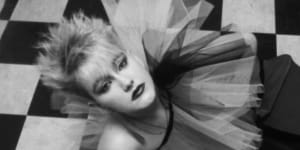
Shannon models the dress that Jude Hotchkiss made for New Year’s eve on 30 December,1981.Gerrit Fokkema
Symbols,expressions,searing messages.
The shop,however,says not a word.
The only clue to its purpose is a hieroglyph,an Egyptian eye over the mathematical sign of thepi. This is the symbol of Katie Pye,the clothes artist. The shop with no name is pronounced “Hieroglyphics”;though this is painted and hardly ever written.
Katie Pye,as gallery brochure legends have it,was eight years old when she was given her first sewing machine. She used it like a sculptor uses a chisel,like a painter uses an oil tube. From the days of Duzzn’t Madder,her “concept clothing shop” in Balmain,to the work for Little Pink and Black Vanity,Katie Pye constructed art clothes,fantastical garments into which one steps as through a sculpture,into the looping and stitching,the very bric-a-brac of the imagination.
The 29-year-old former painter is now the grand dame of Sydney art garments. Her mind-bending creations with no name sayKatie Pye.
The Hieroglyphics shop in Darlinghurst was opened last November on Friday 13. One half of the shop doubles as a small gallery for young artists;along its other walls are Katie Pyes. George Nezovic,Miss Pye’s partner,says the store was intended to be “a showcase for Katie’s most extraordinary works.”
The shop is opulent,a sarcophagus to the spirit of Miss Pye. Soft silver-grey lines the walls,a slim 1950s chair sits sharp in a corner. A receptionist’s desk swirls nouveaux. Built into its wood is a fish tank,its Lurex-like water glistening. Button-sized tropical fish,sapphire and orange,zip and zig-zag through tapering weeds.
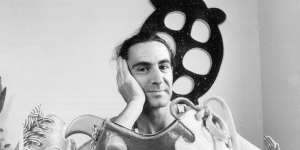
Peter Tully in his work room with his shoes. December 29,1981.Gerrit Alan Fokkema
Hieroglyphics contains exhibition work:Black Boot by Victor Rubin,a collage of mouldering shoe,speared with garbage-heap wood,nails and a used McDonalds-ish fork. There is Rene Boulten’s Reporter,a papier-mache poem to the easy cliche,with its newshound’s sloppy tie and presscard-on-borsalino.
Boy and Girl by Dolly Manon are the distant relatives of art clothing. They are art furnishings,two gigantic felt cushions which act as frames to the girl and boy leaping out in a “feely” collage of satin,curls,and jocks.
Art clothes have no link with “the latest.” Designers of art clothes do not travel to Europe twice a year to keep up with the couturier collections. Art clothes do not limit themselves exclusively to any material whether natural or synthetic.
Art clothes are related to the current concerns of music and painting. Art clothes are moving sculptures and canvases which use the human body as an element,as an additional,often desirable,but not essential method of presentation.
The Katie Pyes,for instance hold some surprises for the naive,dress buyer. The clothes have no “end”;they fold in upon themselves,reverses are exteriors and outsides are insides. They are an Alice in Wonderland puzzle of corners and colours,a textile journey through underworlds of fabric which emerge as “suits”,“dresses” or “jackets.” Looking at a Katie Pye is as satisfying as a game of chess.
Art Clothes,the first exhibition of contemporary wearable art objects held at the Art Gallery of NSW one year ago,blessed designers with official recognition as artists.
The organiser,Jane de Teliga,assistant curator of prints and drawings,recalls pushing hard to overcome the stigma attached to fashion in the art world:“Fashion is a little bit too lightweight for some. But I wanted to show people that art could be accessible,that it doesn’t have to be a big philosophical thing.”
DAY-GLO pinks,lime nylon and limp green tulle,hang on Peter Tully’s front door. Inside the colours repeat and pulse:fluorescent colours,colours with a power of their own;electric,vivid colours set in formica tabletops,record covers and Christo-style,nylon-wrapped furniture tied with luminous threads.
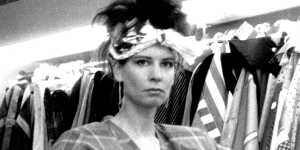
Clothes designer Katie Pye from Hieroglyphics photographed in the shop at East Sydney. December 16,1982.Anton Cermak
“It’s all about colour,” blinked Peter Tully describing his work.
Tully is a grand master of body decoration;his wizardry with modern materials has long been recognised. He is a favourite with the Australian National Gallery’s decorative arts collection,with Ace Bourke the art consultant,with Flamingo Park designers Linda Jackson and Jenny Kee,with Katie Pye.
Peter Tully’s small studio blazes with brilliant plastics,mirrors,vinyls,perspex,rubber tubing. Lengths of fake fur drip from ceiling to floor. “I brought a lot of materials back from New York. Materials you can’t buy here,” he said,showing a prized piece of clear plastic with an opalised coating.
“Sometimes I can walk into Nock and Kirby’s and see a nylon bathmat and it’s exactly what I want. Other times I scour for a particular colour of rubber band for weeks.”
The bits and pieces he hoards in numerous fruit salad containers on his shelves find homes. A pair of ear decorations features miniature plastic feet,Lurex lips on green mirror discs,silvery hands with dolls eyes on orange bars.
From Urban Tribalwear,his body decorations,Tully’s work is expanding into sculptural pieces such as “Tulips of the Night”,a stand with flower heads bursting out of a bowl in fluorescent materials. These mind-blinking “Tulips” were recently acquired by the Australian National Gallery.
Furniture,floats for the Sydney Festival Parade and costumes are currently on Peter Tully’s mind.
“If I could explain it all — the particular philosophies and emotions in it — I wouldn’t be doing it.”
JUDITH Hotchkiss opened her door wearing a gold Lurex top,striped two-tone orange stretch pants pushed up at the knee and stilettos. Her hair flipped in a pigtail over her face.
That morning she finished the New Year’s Eve dress designed to the sole instruction:“Make me an outrageous dress.”
The masterpiece twists on a hanger. It is a black silk dress with a huge multi-coloured tutu tulle collar. It was inspired by “a shop in Leichhardt which has its tulle in stacks,one on top of another. They were brilliant. If I hadn’t seen them like that I wouldn’t have thought of it. I see the dress as oranges with a touch of blue highlighted on black.”
Judith learnt needlework while stuck out in the middle of the Pilliga scrub. She has always sewn her own clothes,then sewn them for friends. Eighteen months ago,after six years of teaching high school maths and primary schoolchildren she settled down to make clothes for a living.
Her bread and butter comes from a Paddington markets stall where she sells cotton fashion pants. Her art clothes are a luxury.
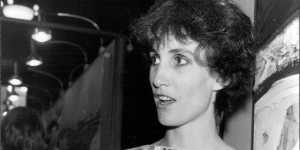
Sue Norrie wears one of her creations on February 1,1983.Philip Wayne Lock
But she is unknown in the competitive fashion industry:“I have to go out of my way to try and charm the pants off the shop owners before they’ll look at my clothes.”
“Some don’t really understand the ideas. They call them punk and they’re not what I’d call punk. They’re worried fake fur collars will prickle without appreciating the fur’s effects.” A few regular outlets buy her clothes.
One of her favourite dress designs flashes little lights in sequence. Fed by a small lumpy battery pack,a tube of lights is fixed on a bronze bib with electrical leads attached with claws crossing the bib.
“I like to put things on clothes,” she says. “I’ve been through a phase of electrical wiring.”
JULIE Cunningham,26,knits clothes in a roof attic in Woolloomooloo.
Hundreds of bulky balls and cones wrapped with brilliant shiny cottons,wools,raffia,spun linen and knobbly silk line shelves,sit in cases and baskets. Squeezed into the oddly shaped,low-ceilinged room are two knitting machines and an old black Singer that has just broken down:“I put it through too much work.”
Julie graduated from Alexander Mackie art school two years ago. She is now completing a post graduate art course,making an 18-minute animated film calledWhatsabody with an Australian Film Commission grant and knitting clothes:“All through art school I was making clothes to get by — I knitted my way through college.”
Eight years ago Julie hand-knitted landscape jumpers with midnight blue skies dotted with stars,or seagulls and rocky headlands with bare forked trees:“I remember my ‘favouritist’ jumper was a landscape connected with paintings I was doing at the time;they had a feeling of a European winter with autumn colours. A lightning bolt separated the landscape into two parts.”
When Australiana grew popular she was commissioned to knit an Australiana jumper with a twist;a chorus line of kangaroos hit by a lightning bolt in front of a brick veneer home.
She moved onto full bodysuits run up on knitting machines. Her latest knitting machine is computerised. It knits pictures,words and complicated patterns. Drawings of women from prehistoric cultures on computer cards are laid on the drawing board. They feed into the knitting machine which reads them photo-electrically and sets up the stitches.
“It’s really liberating.”
SUE NORRIE almost disappears into the walls of her Leichhardt home. The rooms have the texture of her paintings and T-shirts,her colours are everywhere:faded soft red and grey armchairs,an old acqua chair,a basket of shells,a table home-Duluxed in apricot gloss,a curtain rippling with the slashes and abstractions of her own work.
A Sue Norrie T-shirt sells for around $50-$60. It seems an astonishing price for the Great Ocker Uniform,the national rag. It is a small price however for a painting,a moving abstract which absorbs the eye for hours. These are paintings which have the advantage of being able to protect you from sunburn;they can be taken to parties,thrown in the wash.
When Sue Norrie began her T-shirt art four years ago,it worried her. She was a serious artist,a former student of the National Gallery School of Victoria;she had worked with the mentally retarded as an art therapist,she had travelled in Europe,Britain and Japan,she had exhibited. T-shirts;they made her feel uneasy.
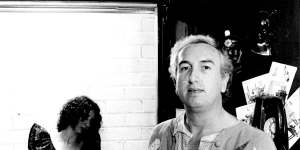
Anna-Maria models with Jann Harris in his Double Bay shop on December 29,1981.Gerrit Alan Fokkema
“After six months,I stopped doing them. I freaked out. I was a painter,I thought I’d better stop doing this sort of thing.” In 1979 she was drawn back to T-shirts but soon “began to flip out again. I was still questioning it,thinking ‘Oh God,this is a really bad thing to do.‘”
Sue Norrie’s T-shirt work is now acknowledged as extraordinary. Katie Pye features Norrie garments at Hieroglyphics. Though Norrie does not view them as intensely as her “serious” art,her abstracts on T-shirt material are said to be of a style “more spontaneous and decorative than that of her paintings.”
“I live off the shirts now. I see them as good,in that they are an extension of my painting. They are abstract,but because they are functional objects they break the ‘abstract’ thing. They are not behind glass,they are getting out to people.
“T-shirts are really the most basic Australian canvas,a commodity,a common denominator. I don’t work in the sense of ‘wow,painting T-shirts,what a hippy thing to do’;I am not interested in painting clothes. I think of the T-shirts as canvases,I have never seen them as fashion.”
THE ART clothes movement has spread to Double Bay,where it has effected a smooth and elegant compromise with fashion. Jann Harris,a designer whose background includes theatre and television,operates Artclothes in the Bay Lodge Arcade.
The shop opened in May last year. It has the calmness of a boutique. The shop’s garments are not one-off creations. They can be constructed to the client’s specifications. The imagination and expressiveness of the styles however,are related to the art clothes genre.
Harris is a graduate of the NIDA theatre design course;his work has a presence,“actors and actresses were always trying to pinch my costumes. I build from dialogue,what’s happening in the streets.”
Through Harris’s work run the design pre-occupations of the times;the Flamingo Park Australiana obsession over jumpers and sweat-shirt dresses crawling with kangaroos and gum-leaves,the vaguely renaissance,part-New Romantic tafettas and silks,the spilling tulle-and-plastic skirt-sprays,the Lurexes of wearable art.